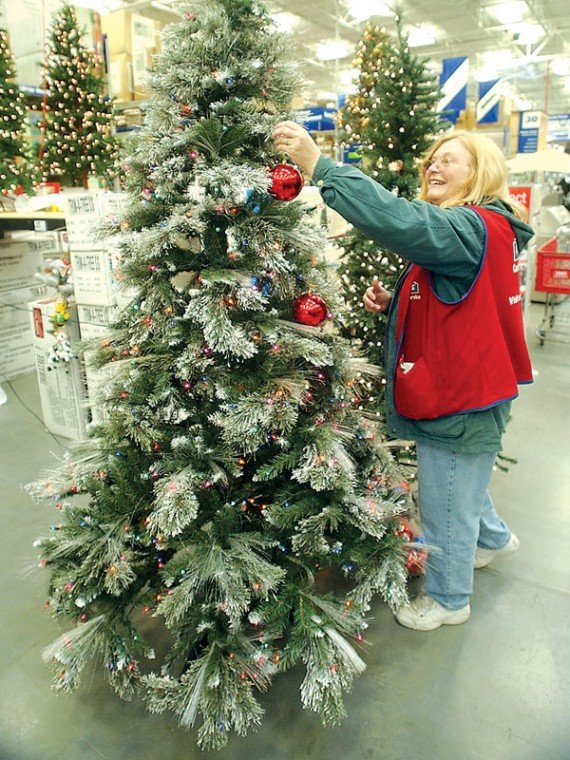Gilroy
– If shopping for that perfect gift wasn’t daunting enough, try
finding the perfect Christmas tree.
With a plethora of choices consumers now have more options than
ever when doing their annual Christmas tree shopping.
At Battaglia Ranch Christmas Tree Farm in San Martin, families
have been pouring in steadily since the farm opened after
Thanksgiving to pick their pre-cut trees or choose and cut their
own.
Gilroy – If shopping for that perfect gift wasn’t daunting enough, try finding the perfect Christmas tree.
With a plethora of choices consumers now have more options than ever when doing their annual Christmas tree shopping.
At Battaglia Ranch Christmas Tree Farm in San Martin, families have been pouring in steadily since the farm opened after Thanksgiving to pick their pre-cut trees or choose and cut their own.
“It’s a happy time for a lot of people, when people are going about trying to select their tree,” said Paul Battaglia, co-owner of the farm along with his brother and sister-in-law.
The most popular native tree at Battaglia is the Monterey pine, mainly for its pleasant fragrance and long life, Paul Battaglia said. Those trees sell for $5 per foot, with the average tree costing between $30 and $40. Noble firs, the most expensive tree Battaglia sells, are about $50 to $60 per tree, because they take about twice the time to harvest and are shipped from the Pacific Northwest.
While visiting a friend in Gilroy on Sunday, Amy Larson of Morgan Hill said she decided to pop into a Christmas tree lot near First Street and Kern Avenue. To Larson and her husband, who buy real trees every year, the artificial version is a poor imitation.
“We just really like the fragrance and the Christmas-y feeling of a real tree,” Larson said. “Maybe when we get really old and don’t want to deal with lugging a real tree inside the house, we’ll consider getting a fake one.”
At Target in Gilroy Crossing, a variety of artificial trees offered customers several prices and styles. One of the most expensive trees, a 7-foot Austrian pine with 550 mini-lights, attached pine cones and a metal stand, sold for $199.99. Cheaper trees included a 6-foot slim noble fir with a plastic stand, going for $16.99.
Justin Ngai, an assistant manager at Target, said sales of artificial trees have been strong this year, and sales of real trees have been exceptional. The store will receive a second shipment of real trees in the next few days, he said. The most popular real tree has been the 5- to 6-foot Douglas firs for $22.99.
For Target customer David Morales, the hassle and fuss of a real tree just isn’t worth it. About five or six years ago, Morales said, his real tree tipped over inside his Gilroy home, showering his carpet with a mess of needles that stuck through several furious vacuuming sessions.
Since then, Morales has purchased two artificial trees and shopped Tuesday for a third.
“A lot of people think there’s only one kind of artificial tree, but there are so many, and you can really do a lot with them,” he said. “And you don’t have to water it or vacuum under it or anything. They’re so easy.”
Sales of real trees have taken a hit over the past few years as more consumers opt for their artificial counterparts. Between 35 and 38 million real trees were sold nationwide about five years ago, but since then, that number has dipped to about 25 million per year, Battaglia said. Purchases of real trees are just beginning to climb back up, and for the first time, the National Christmas Tree Association this year has coordinated a number of cross-promotional efforts to promote real trees.
If customers bring in ticket stubs from “The Polar Express,” they’ll receive $3 off their tree at Battaglia and Ludewig’s San Martin Christmas Tree Farm, 13865 Monterey Road.
John and Tina Bourdet, from Hollister, run a tree farm and lot in Hollister, as well as two lots in Gilroy. Although sales this year have been strong, John Bourdet said some business gets taken by bigger retailers.
“We’re having a good season, but we are feeling the effects of the big-box stores,” he said.
Bourdet said real trees are central to the experience of Christmas, especially for children, and artificial trees just don’t hold the same magic.
“An artificial tree is a hunk of plastic that is not biodegradable,” he said. “A mother yanking a hunk of plastic out of a box, with the father inside watching a football game and the children playing down the street – now that’s a real Christmas, isn’t it?”













